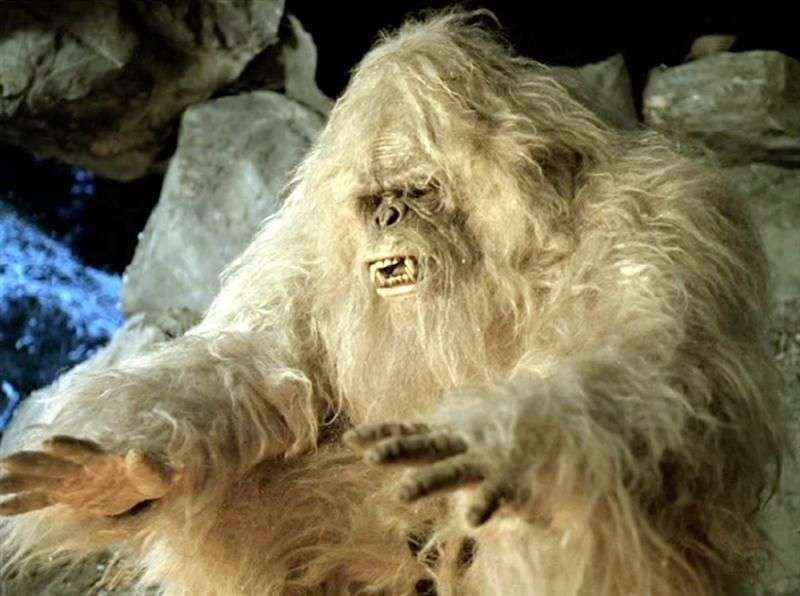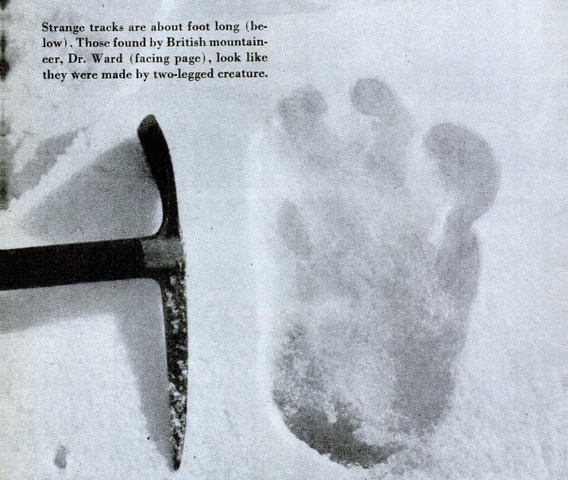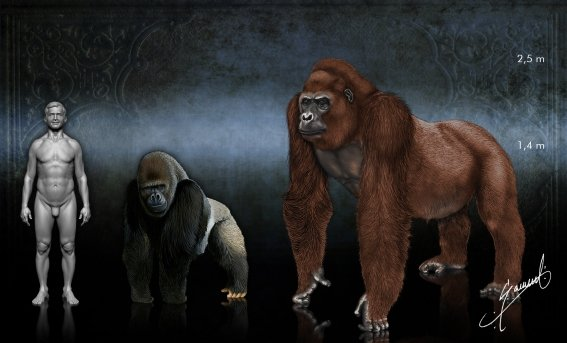Yeti
Yeti
Hi friends, that's it, the weekend has finally arrived, we will be able to slow down the pace and let live quietly until Monday; o)
I am a fan of the bigfoot movie and out of curiosity, I wanted to know a little more about his "cousin" of the cold regions, the Yeti.

The Yeti or abominable snowman is a creature of folklore from Nepal, India, Bhutan and Tibet. Due to the lack of material proof of its existence, the scientific community considers it a legendary being.
Equivalent creatures exist in many parts of the world such as bigfoot in North America, sasquatch in Canada or almasty in the Caucasus.
A study from the State University of New York brought new information about this legend. It is based on the analysis of nine samples of museums and private collections that are supposed to belong to yetis: bone, tooth, skin, hair, excrement from the Himalayas and the Tibetan plateau.
According to the results of the genetic study, one sample came from one dog and the other eight from Asian black bears, Himalayan brown bears or Tibetan brown bears. The results of the study strongly suggest that the biological basis of the legend of Yeti can be found in local bears.
This research provides information on the evolutionary history of Asian bears, some of which, like the brown bears of the Himalayas, are currently under threat. Scientists sequenced the DNA of 23 Asian bears, including that of the so-called Yeti, and compared it to that of other bears around the world.
The analysis showed that the Himalayan brown bears belong to a line that diverged early compared to other brown bears about 650,000 years ago, during a glaciation. The growth of the glaciers had to separate the Himalayan bears from the others, which explains why they had evolved independently.
History
The word Yeti comes from Tibetan, a word made up of "rocky" and "bear".
The abominable snowman expression appeared in 1921 when following an expedition for the exploration of Everest, Lieutenant-Colonel Charles Howard-Bury reported in a book, the report of the crossing of Lhakpa-la to 6.400 where he observed footprints which he considered to be caused by a great gray wolf which formed in the snow a double trace similar to that of a barefoot man. He added that his guides spontaneously revealed that the traces must be those of the wild man of snow.
B.H. Hodgson is the first European to refer to the Yeti. The first impressions of human footprints by Europeans date back to 1905. In 1925, the British Royal Geographical Society's NA Tombazi explorer and John Hunt reported observing footprints of the yeti at the glacier site. from Zemu to Sikkim.
In 1936, the Swiss geologist Augusto Gansser made an exploratory voyage for 8 months in Garhwal, between the Nanga Parbat and Everest, in the heart of the Himalayas, where he saw the Yeti.
In April 1942, Slavomir Rawicz made his way to the northern Indies after escaping from the Soviet Gulag and crossing the border between Tibet and Sikkim, two creatures whose silhouette recalls the bear or a great monkey like Orangkim. utan.
Footprints were taken in 1951 by mountaineer Eric Shipton.
In 1955, during another expedition, Fr. P. Bordet, a French geologist, was able to follow traces over more than one kilometer and thus affirm that they had been produced by a bipedal animal. Several of these photographs were published and then they were drawn by Hergé in his Tintin album in Tibet.

In March 1976, at an altitude of 5,300 meters in the Rolwaling in the Himalayas, René de Milleville photographed a footprint in very distinct snow. He will have the opportunity to report numerous stories of Nepali peasants testifying to having seen the Yeti. He has made available to the National Museum of Natural History bristles attributed to the Yeti.
Renowned mountaineer Reinhold Messner embarks on an expedition in the footsteps of the animal in the late 1980s, he would have seen the Yeti one night in July 1986 while he was looking for a village to shelter in a lost valley of the Himalayas. At the end of his expedition, Messner concludes that the legend of the abominable snowman comes from the Tibetan Blue Bear that terrified local people for generations. This unknown bear would have the ability to walk on his hind legs and would have become a wild man in local folklore.

In 1997, two French adventurers discovered, while crossing the Bobang pass in Indian Kashmir, mysterious traces in the snow that would not be those of a man, nor those of a bear. They climb straight up a slope.
Scientific Opinion

For most scientists, anthropologists or sociologists, the Yeti is a legendary creature from the mythology of Himalayan groups. The arguments against the real existence of Yeti are numerous :
• absence of fossil or cadaver of an individual likely to be studied scientifically;
• impossibility for a population to maintain itself over time with such a small number of people as they are almost never seen;
• low reliability of most testimonials and observations;
• consistency between descriptions and myths related to wild men;
One of the hypotheses is that the Yeti comes from a big monkey known in South China, the Gigantopithecus.
Others liken it to fossil primates from India or orangutan, and some from Neanderthals.
According to a doctor of zoology at the Free University of Brussels, traditions that revolve around the Snow Man could refer to three types of primates whose ranges sometimes overlap.
Hiker testimonials in the Himalayas show characteristic footprints in the snow, excrement and found hairs, veterinarian and zoologist Michel Tranier of the National Museum of Natural History attributes them to an orang-utan.
Some cryptozoologists (animal researchers whose existence can not be proven conclusively, these animal forms are called cryptides) believe that the gigantopithecus is likely to be the probable ancestor of the Yeti and Bigfoot, the
According to specialists, it would be Neanderthals who survived or representatives of the species Homo erectus that evolved parallel to our species.
So great monkey, prehistoric man who would have developed differently from men or abominable snowman, the doubt remains ...
Harry and the hendersons lol
Hello @lndesta120282 unfortunately I do not have a day off tomorrow :)
I have heard a lot about the snowman in my whole life. Most of all, information about him is full of pseudo-scientific journals and television programs. Some even give out some kind of photos for genuine ones.
I think that he did not unfoundedly appear in the minds of people and they talk so much about him. But as long as there is no direct evidence about the snowman - it's more like a legend.
Thanks, very interesting article
Do you believe in a Yeti? :)
I do, this is my friend

Oh Harry my friend ;o)
why not? I am a dreamer ;-)
@lndesta120282,great information about Yeti you have shared with us.I am from India and in India Yeti is called as हिममानव himamānav "snow man".and yes Bigfoot is also my favorite movie,I really enjoyed it.Thank you @lndesta120282 for giving us great knowledge about mountain legend "Yeti".
Great post, interesting informations.

Great post, The Yeti is Amazing. I love it
excellent post, thanks for good sharing
Hello! I am your regular follower and your writing skills are amazing. At the start of article you said "The Yeti or abominable snowman is a creature of folklore from Nepal, India, Bhutan and Tibet" but a few days ago, an blogger said this creature is from Zimbabwe and only found in Zimbabwe! Is this true?
Good post.
I like this..
Your blog is very informative and I really enjoyed readind it. When I was a child, i also thought of it as Bigfoot when sunny and Yeti when cold... 😂